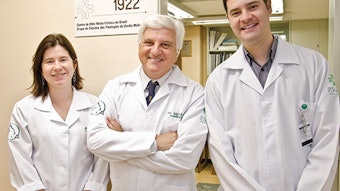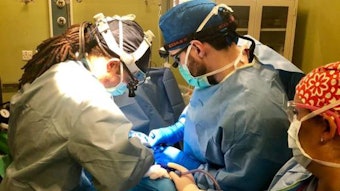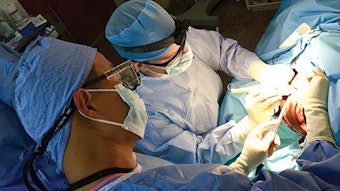Tympanostomy tube placement
Out of Committee Uchechukwu C. Megwalu, MD; Scott E. Brietzke, MD, MPH; Jennifer J. Shin, MD, SM; Vikas Mehta, MD, Outcomes Research Evidence-Based Medicine Committee In this Bulletin segment, the American Academy of Otolaryngology–Head and Neck Surgery Foundation (AAO-HNSF) Outcomes Research and Evidence Based Medicine (OREBM) Committee shares highlights from a 2017 study: “Quinolone Ear Drops After Tympanostomy Tubes and the Risk of Eardrum Perforation: A Retrospective Cohort Study.”
Out of Committee
Uchechukwu C. Megwalu, MD; Scott E. Brietzke, MD, MPH; Jennifer J. Shin, MD, SM; Vikas Mehta, MD, Outcomes Research Evidence-Based Medicine Committee

In this Bulletin segment, the American Academy of Otolaryngology–Head and Neck Surgery Foundation (AAO-HNSF) Outcomes Research and Evidence Based Medicine (OREBM) Committee shares highlights from a 2017 study: “Quinolone Ear Drops After Tympanostomy Tubes and the Risk of Eardrum Perforation: A Retrospective Cohort Study.1” The focus of this ongoing series is to highlight articles that may alter surgical practice and to discuss the strengths and limitations of these publications.
Tympanostomy tube (TT) placement is the most commonly performed ambulatory surgery in children. Tympanic membrane perforation has historically been considered an uncommon complication; however, recent studies have reported that the rates may be higher than have been previously quoted. Due to the large numbers of TT placements performed each year, even a slight increase in the risk could have significant population impacts. Quinolone antibiotic ear drops are often recommended for post-TT otorrhea and are the preferred topical antibiotic due to the ototoxic effects of aminoglycosides (i.e., neomycin). Systemic use of quinolones has been linked to detrimental effects on collagenous tissue in humans. Topical quinolone preparations have also been reported to have toxic effects on fibroblasts and corneal cells in vitro, in vivo, and in clinical trials. This retrospective cohort study investigated whether otic quinolones were associated with persistent tympanic membrane perforation in comparison to otic neomycin plus hydrocortisone preparations.
The study was conducted using Medicaid Analytic eXtract files, which included billing data for inpatient and outpatient encounters from 29 U.S. states between 1999 and 2006. The study cohort included children fewer than 18 years old without predisposing factors for perforation during a six-month look-back period, who received antibiotic ear drops after TT-tube placement. Included ear drops were quinolones (ofloxacin, ciprofloxacin plus hydrocortisone, or ciprofloxacin plus dexamethasone) or neomycin plus hydrocortisone. Patients receiving quinolone ear drops were compared to patients receiving neomycin plus hydrocortisone ear drops. The outcome of interest was persistent tympanic membrane perforation, which was defined as an inpatient or outpatient encounter associated with an International Classification of Diseases, Ninth Revision (ICD-9) diagnosis code for tympanic membrane perforation followed by a tympanoplasty. Time-dependent Cox regression models were used to analyze risk of persistent tympanic membrane perforation, adjusting for patient sex, race, the calendar year at study entry, and diagnoses at the time of TT placement as fixed covariates. TT reinsertion, adenoidectomy, and number of ear drop prescriptions were also included as time-varying covariates.
A total of 96,595 children were included in the study. Of these, 78,275 received quinolones; the remainder received neomycin plus hydrocortisone. A total of 364 tympanic membrane perforations requiring tympanoplasty occurred during follow-up. Patients exposed to quinolone ear drops had a higher risk of perforation requiring surgery (adjusted hazard ratio [HR] 1.61, 95% confidence interval [CI], 1.15–2.26). An increased frequency of any ear drop prescriptions was also associated with higher risk of tympanic membrane perforations (HR, 1.14 [95% CI, 1.11–1.17]). The risk of tympanic membrane perforation varied with specific quinolone preparations. The adjusted hazard ratios were 1.49 (95% CI, 1.05–2.09) for ofloxacin, 1.94 (95% CI, 1.32–2.85) for ciprofloxacin plus hydrocortisone, and 2.00 (95% CI, 1.18–3.41) for ciprofloxacin plus dexamethasone.
Findings and Recommendations
The findings of this study suggest that use of quinolone ear drops in children with TTs is associated with an increased risk of persistent tympanic membrane perforation requiring tympanoplasty. The perforation risk persisted even after accounting for the number of times any ear drops were needed after TT placement. This risk is more pronounced when quinolones are combined with corticosteroids. This study was limited by its retrospective nature and lack of randomization, as well as limitations inherent to claims data (selection bias, confounding, and misclassification bias). Additionally, the use of tympanoplasty as the outcome likely under-represents the risk of tympanic membrane perforation, but it does more definitively identify those patients who have a persistent perforation requiring definitive surgery. Thus, the findings need to be interpreted in light of these limitations. Furthermore, while neomycin plus hydrocortisone was associated with lower risk of tympanic membrane perforation, this benefit must be balanced against the possible risk of sensorineural hearing loss with exposure to otic aminoglycosides in the presence of a TT.
Ideally, there would exist a preparation that does not increase the risk of hearing loss or the risk of perforation. However, since this option is currently not available (except as off-label use of ophthalmic drops), perhaps the takeaway should be to avoid the over-prescription of ear drops by limiting the use of drop preparations with corticosteroids unless a clear indication is present. The AAO-HNSF Clinical Practice Guideline: Tympanostomy Tubes in Children2 contains recommendations regarding the use of topical antibiotic preparation in TT patients and can help guide clinicians on when to prescribe topical antibiotic preparations and/or use more aggressive interventions.
References:
1. Alrwisan A, Antonelli PJ, Winterstein AG. Quinolone Ear Drops After Tympanostomy Tubes and the Risk of Eardrum Perforation: A Retrospective Cohort Study. Clin Infect Dis. 2017 Apr 15;64(8):1052-1058.
2. Rosenfeld RM, Pynnonen MA, Hussey HM, et al. Clinical Practice Guideline: Tympanostomy Tubes in Children. Otolaryngol Head Neck Surg. 2013; 149(Suppl 1): S1-S35













